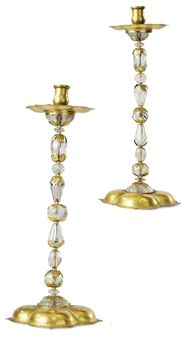Paire de bougeoirs en cuivre doré et cristal de roche, Italie du nord, probablement Milan, début du XVIIIème siècle
Paire de bougeoirs en cuivre doré et cristal de roche, Italie du Nord, probablement Milan, début du XVIIIème siècle
Chacun surmonté d'un binet sur une bobèche de forme quadrilobée, le fût balustre alternant cristal de roche et cuivre doré ciselé; reposant sur une base en cuivre quadrilobée; les binets et les disques d'époque postérieure; légers manques et restaurations mineurs. Hauteur: 36.2 et 37 cm. (14¼ et 14½ in.) (2) Estimate €40,000 - €60,000
Notes: La sculpture sur cristal de roche, ce quartz incolore, était une forme d'art hautement prisée dans l'antiquité qui bénéficia d'un regain d'intérêt en Europe occidentale au XIVème siècle. La beauté du matériau réside dans sa transparence, comparable à celle du verre; il excerçait en outre un fascination en raison de sa dureté et du talent requis pour le travailler. Il était essentiel pour tout collectionneur de la Renaissance de posséder des sculptures ou des objets en cristal de roche cristal de roche, comme gage de son rang; les collections d'ouvrages en cristal de roche faisaient également la fierté des cours les plus prestigieuses d'Europe. Exposés dans des cabinets de curiosité, ils étaient prisés par la diplomatie qui avait pour habitude de les offrir en cadeaux aux personnalités importantes.
A Pair Of Rock Crystal And Gilt-Copper Candlesticks, North Italian, Probably Milan, Early 18th Century
Each surmounted by a nozzle, above a lobed quatrefoil drip-pan, alternating carved rock crystal and gilt-copper baluster stem and lobed gilt-copper quatrefoil base; the nozzles and discs later, minor losses and repairs
The art of carving in rock crystal, the colourless variant of quartz, was a highly treasured art-form in antiquity but one that also gained a renewed interest in western Europe from the 14th century. The beauty of the material is its glass-like transparency, however, there was also a great fascination with its hardness and the amount of skill required to carve it. Not only was it essential for a renaissance collector to own the finest rock-crystal carvings or vessels as symbols of his high status, but also collections of works from crystal were the pride of the largest courts of Europe. Cut crystal vessels decorated treasure rooms and kunstkammern and also served as diplomatic gifts.
Christie's. Collection Yves Saint Laurent et Pierre Bergé. 23 - 25 February 2009. Paris www.christies.com Image Christie's Ltd 2009

/https%3A%2F%2Fprofilepics.canalblog.com%2Fprofilepics%2F1%2F0%2F100183.jpg)
/https%3A%2F%2Fstorage.canalblog.com%2F03%2F02%2F119589%2F96711876_o.jpg)
/https%3A%2F%2Fstorage.canalblog.com%2F11%2F31%2F119589%2F94773502_o.jpg)
/https%3A%2F%2Fstorage.canalblog.com%2F20%2F83%2F119589%2F94772815_o.jpg)
/https%3A%2F%2Fstorage.canalblog.com%2F26%2F72%2F119589%2F75604929_o.jpg)
/https%3A%2F%2Fstorage.canalblog.com%2F59%2F60%2F119589%2F26458628_o.jpg)



/http%3A%2F%2Fstorage.canalblog.com%2F89%2F93%2F119589%2F127899898_o.jpg)
/http%3A%2F%2Fstorage.canalblog.com%2F81%2F83%2F119589%2F120714101_o.jpg)
/http%3A%2F%2Fstorage.canalblog.com%2F84%2F63%2F119589%2F120641874_o.jpg)
/http%3A%2F%2Fstorage.canalblog.com%2F98%2F01%2F119589%2F115928748_o.jpg)